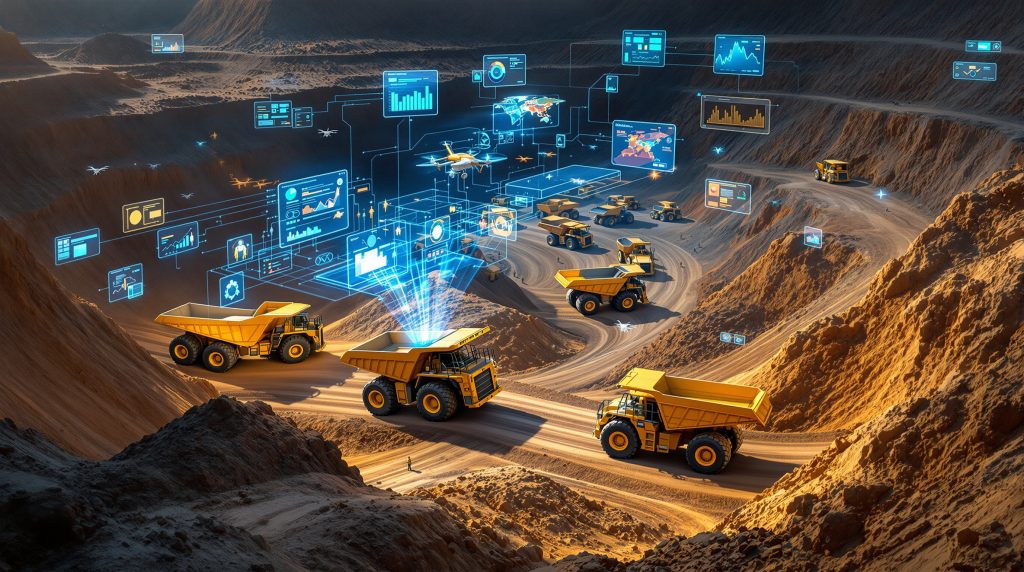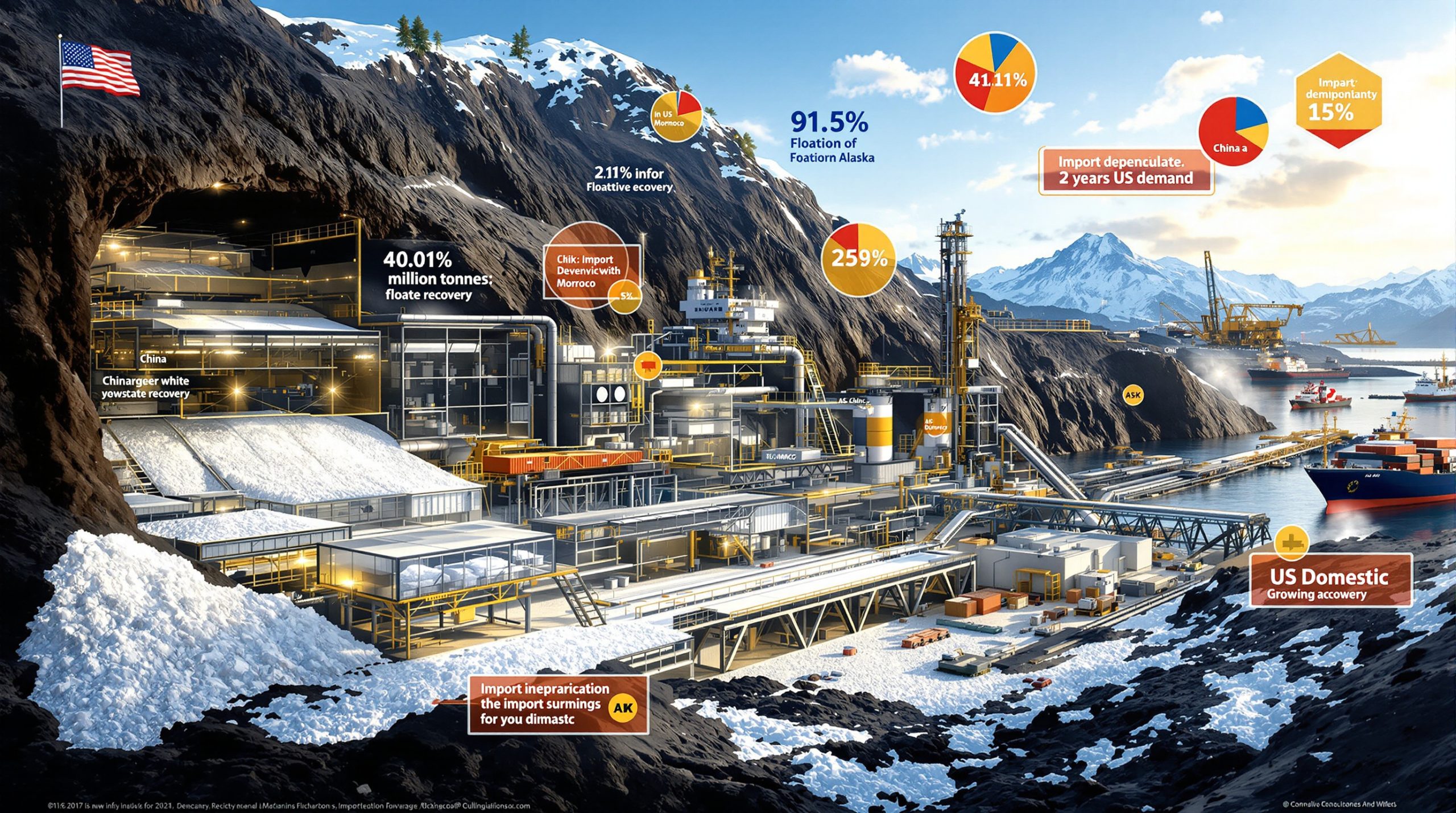How is Digital Technology Reshaping Mining Operations?
Digital transformation in mining is fundamentally reshaping the mining industry's operational landscape. With unprecedented demand for critical metals driven by clean energy technologies, mining companies face mounting pressure to overcome traditional challenges while improving efficiency and sustainability. Modern mining operations now leverage sophisticated digital ecosystems that enable real-time decision making, predictive maintenance, and autonomous functions.
The mining industry faces significant hurdles including 15+ year lead times for new mines, increasingly remote project locations, global talent shortages, and rising operational costs across energy, labor, equipment, and transportation. These challenges make the adoption of digital technologies not just advantageous but essential for competitive survival.
According to the International Energy Agency, electric vehicles require six times more minerals than conventional vehicles, while offshore wind farms need nine times more mineral resources than gas-fired power plants. This escalating demand is driving mining operators to embrace mining industry evolution at an accelerated pace.
Mining companies implementing comprehensive digital strategies are gaining distinct advantages through optimized resource extraction, reduced operational costs, enhanced safety protocols, and improved environmental performance. The gap between digital leaders and laggards continues to widen, creating a clear competitive divide within the industry.
Key Technologies Driving Mining's Digital Revolution
Artificial Intelligence and Machine Learning
AI and machine learning algorithms are revolutionizing mining operations through advanced pattern recognition and predictive capabilities. These powerful technologies enable:
- Predictive maintenance systems that identify equipment failures before they occur, reducing downtime by up to 40% according to industry benchmarks
- Geological modeling enhancements that improve ore body understanding through complex data analysis
- Real-time production optimization with continuous monitoring of operational parameters
- Safety incident prediction by identifying potential hazards through pattern recognition
AI in drilling and blasting has demonstrated the ability to reduce equipment downtime by up to 20%, according to implementation data from mining operations across multiple commodities. These systems analyze equipment performance data to detect anomalies before they escalate into failures.
Internet of Things (IoT) and Sensor Networks
Modern mining operations are becoming increasingly connected environments where equipment, infrastructure, and personnel are integrated through sophisticated IoT networks:
- Smart sensors continuously monitor equipment health, environmental conditions, and production metrics
- Wearable technology tracks worker locations and vital signs to enhance safety protocols
- Environmental monitoring systems provide real-time data on air quality, water usage, and sustainability metrics
- Connected fleet management enables centralized control of mobile equipment
Implementation of unified data environments has enabled mining companies to access up to ten times more data points compared to traditional systems. K+S Potash Canada's implementation of a collaborative platform eliminated errors in raw data through a single source of truth architecture, significantly improving operational visibility.
Autonomous and Remote Operations
The shift toward autonomous equipment and remote operations centers is fundamentally changing how mining activities are conducted:
- Self-driving haulage trucks operate continuously with consistent performance
- Autonomous drilling systems achieve greater precision while removing operators from hazardous environments
- Remote operations centers allow skilled personnel to monitor and control multiple sites simultaneously
- Drone technology enables advanced surveying, stockpile measurement, and safety inspections
Remote operations capabilities are particularly valuable as mining projects move to more isolated locations with challenging environments. These technologies not only improve productivity but significantly enhance safety by removing personnel from high-risk areas.
Digital Twins and Simulation
Virtual replicas of physical assets and operations provide powerful tools for optimization and planning:
- Mine-wide digital twins simulate entire operations to identify bottlenecks and optimization opportunities
- Process optimization through virtual testing before implementing operational changes
- Training simulations prepare workers for complex tasks in risk-free virtual environments
- Life-of-mine planning with enhanced accuracy and adaptability to changing conditions
Digital engineering platforms enable EPCs and owner-operators to run multiple build-out scenarios with varying inputs and constraints. This capability results in better capital allocation decisions and fewer financial overruns through enhanced visibility into potential outcomes.
What Benefits Are Mining Companies Realizing Through Digitalization?
Enhanced Operational Efficiency
Digital technologies are driving significant productivity improvements across all aspects of mining operations:
| Operational Area | Potential Efficiency Gain | Key Digital Technologies |
|---|---|---|
| Extraction | 15-30% increased throughput | Autonomous equipment, AI optimization |
| Maintenance | 25-40% reduced downtime | Predictive maintenance, IoT sensors |
| Energy Usage | 10-20% reduction | Smart grid technology, AI-driven optimization |
| Processing | 15-25% yield improvement | Advanced process control, digital twins |
According to McKinsey research, mining companies deploying advanced digital technologies and analytics can reduce capital expenditure by up to 20% and cut project delivery times by up to 30%. These improvements translate directly to enhanced competitive positioning and financial performance.
Improved Safety Performance
Digital transformation in mining is creating fundamentally safer work environments through multiple technology applications:
- Remote operation of equipment in hazardous areas, reducing exposure to potential risks
- Real-time monitoring of environmental conditions with immediate alerts to potential dangers
- Enhanced training through virtual reality simulations of emergency scenarios
- Fatigue monitoring systems that prevent accidents before they happen
The shift from reactive to predictive safety management represents a paradigm change in how mining companies approach worker protection. Digital technologies enable a proactive stance where potential hazards are identified and mitigated before they result in incidents.
Environmental Sustainability Advancements
Digital technologies are helping mining companies significantly reduce their environmental footprint:
- Precision resource extraction minimizes waste material and reduces land disturbance
- Optimized water usage through real-time monitoring and closed-loop systems
- Reduced energy consumption through AI-driven efficiency improvements
- Enhanced rehabilitation planning using digital terrain modeling and simulation
As regulatory requirements and stakeholder expectations around sustainable mining transformation continue to increase, digital tools provide mining companies with the capabilities needed to meet these challenges while maintaining operational efficiency.
Cost Optimization Across Operations
The financial benefits of digital transformation extend across multiple operational areas:
- Reduced operational expenses through automation and efficiency gains
- Lower maintenance costs through condition-based and predictive approaches
- Decreased energy consumption through optimized processes
- Extended equipment lifecycle through better utilization and maintenance practices
Design reuse and standardization significantly reduces engineering hours for subsequent projects using template-based approaches. Rio Tinto's implementation of standardized crushing facilities and conveyor systems across operations demonstrates how digital tools can drive greater efficiency, transparency, and cost control across mine development projects.
What Challenges Must Mining Companies Overcome?
Implementation Hurdles and Solutions
Connectivity Infrastructure
Remote mining locations often lack reliable connectivity, creating significant barriers for real-time data transmission:
- Challenge: Limited bandwidth and network coverage in remote areas
- Solution: Hybrid connectivity solutions combining satellite, microwave, and private LTE/5G networks
- Implementation example: Deployment of private wireless networks enabling autonomous haulage and real-time data transfer in remote operations
As mining projects become increasingly remote and technologically complex, establishing robust connectivity infrastructure represents a foundational requirement for digital transformation success.
Legacy System Integration
Many mining operations run on decades-old systems that must be integrated with new digital platforms:
- Challenge: Incompatible data formats and communication protocols across different systems
- Solution: Middleware solutions and phased migration approaches to maintain operational continuity
- Implementation example: Implementation of integration layers between operational technology and information technology systems
K+S Potash Canada faced challenges managing engineering information across 8-9 global offices with multiple third-party providers. Their implementation of a unified data environment successfully connected all stakeholders and eliminated the data inconsistencies that previously hampered operations.
Cybersecurity Concerns
Increased connectivity creates new vulnerabilities that must be systematically addressed:
- Challenge: Protecting critical operational technology from emerging cyber threats
- Solution: Segmented networks, continuous monitoring, and regular security assessments
- Implementation example: Development of industrial cybersecurity frameworks specifically designed for mining operations
As mining operations become more digitally integrated, comprehensive cybersecurity strategies must evolve to protect increasingly connected operational technologies from sophisticated threats.
Workforce Transformation Requirements
The shift to digital mining requires new skills and organizational approaches:
- Upskilling programs to prepare existing workforce for digital roles and responsibilities
- New talent acquisition strategies focusing on data science and automation expertise
- Organizational restructuring to break down silos between operational and technology teams
- Change management initiatives to address resistance and build digital culture
Successful digital transformation requires breaking down traditional silos between technical disciplines, developing digital skills within existing workforce populations, managing resistance to change in established operational practices, and creating governance structures that support digital innovation.
How Are Leading Mining Companies Implementing Digital Strategies?
Strategic Approaches to Digital Transformation
Successful digital transformations in mining typically follow these proven approaches:
- Value-focused implementation: Prioritizing digital initiatives based on potential business impact rather than technology novelty
- Scalable pilots: Testing technologies in controlled environments before full-scale deployment
- Cross-functional collaboration: Breaking down silos between operational and technology teams
- Ecosystem partnerships: Collaborating with technology providers, universities, and even competitors
- Long-term vision with short-term wins: Balancing immediate results with strategic objectives
Leading companies balance immediate results with strategic objectives by starting with high-impact, low-complexity initiatives to build momentum while simultaneously implementing foundational capabilities that enable future innovations.
Case Studies of Digital Success
Rio Tinto's Design Standardization Initiative
Rio Tinto deployed comprehensive digital tools to drive greater efficiency across mine development projects:
- Technology deployed: Suite of digital engineering and design platforms
- Key innovation: First-time replication of an entire crushing facility including conveyor systems from one project to another
- Results achieved: Significant reductions in engineering time and capital expenditure
- Implementation approach: Standardized design templates enabling consistent replication across multiple operations
This approach to design reuse demonstrates how digital platforms can dramatically reduce engineering efforts while ensuring consistency and quality across multiple projects.
K+S Potash Canada's Unified Data Environment
K+S Potash Canada implemented a collaborative data platform to overcome global coordination challenges:
- Challenge: Simplifying access to design and engineering information across 8-9 global offices
- Technology deployed: Unified data environment connecting all stakeholders
- Results achieved: Access to 10x more data points, elimination of raw data errors
- Implementation impact: Reduced miscommunication and rework, smoother handovers, enhanced decision-making capabilities
The implementation created a single source of truth that improved consistency across engineering, procurement, and construction disciplines while enabling seamless data updates to flow automatically to all connected systems.
Integrated Remote Operations Centers
Global mining companies have established centralized facilities to remotely monitor and control multiple operations:
- Technology deployed: Real-time data visualization, digital twins, advanced analytics
- Results achieved: Enhanced decision-making capabilities, optimized resource allocation
- Implementation approach: Gradual transition from monitoring to active control functions
- Workforce impact: Creation of specialized roles for remote operations specialists
These centers enable mining companies to leverage scarce technical expertise across multiple sites simultaneously, improving operational performance while reducing travel requirements and enhancing work-life balance for technical specialists.
What Does the Future of Digital Mining Look Like?
Emerging Technologies on the Horizon
Several technologies are poised to further transform mining operations in the coming years:
- Advanced robotics for maintenance and operations in extreme environments
- Edge AI enabling real-time decision making without connectivity dependencies
- Blockchain solutions for supply chain transparency and ESG compliance verification
- Augmented reality for maintenance support and remote expert assistance
- Quantum computing applications for complex geological modeling and optimization
These technologies will build upon the foundation of current digital platforms to create even more autonomous, efficient, and transparent mining operations capable of meeting escalating demand for critical minerals.
The Evolution Toward Integrated Ecosystems
The future of mining technology lies in creating fully integrated digital ecosystems:
- End-to-end value chain visibility from resource to customer
- Interoperability standards enabling seamless data exchange between systems
- Collaborative platforms connecting miners, suppliers, and customers
- Open innovation frameworks accelerating technology development and adoption
Successful digital transformations involve close, digitally enabled collaboration between owners, EPCs (Engineering, Procurement, and Construction firms), OEMs (Original Equipment Manufacturers), and regulators within single digital ecosystems.
Sustainability Through Digitalization
Digital technologies will play a crucial role in meeting mining's sustainability challenges:
- Precision mining techniques minimizing waste and environmental impact
- Circular economy enablement through digital tracking of materials
- Energy optimization reducing carbon footprint across operations
- Transparent ESG reporting backed by verifiable digital data
As regulatory requirements and stakeholder expectations continue to evolve, digital capabilities will become increasingly essential for meeting sustainability goals while maintaining operational efficiency.
How Can Mining Companies Begin Their Digital Transformation Journey?
Assessment and Roadmap Development
A successful digital transformation begins with thorough preparation:
- Digital maturity assessment: Evaluating current capabilities against industry benchmarks
- Value opportunity identification: Quantifying potential benefits across operational areas
- Technology landscape mapping: Understanding available solutions and their applicability
- Capability gap analysis: Identifying skills and infrastructure needs
- Prioritized roadmap creation: Sequencing initiatives for maximum impact
Organizations should balance building internal capabilities versus partnering with technology providers, considering factors like organizational readiness, available capital, and strategic objectives.
Building Blocks for Success
Key elements that support successful digital transformation include:
- Data strategy and governance: Establishing how data will be collected, stored, and utilized
- Technology architecture: Designing flexible, scalable technical infrastructure
- Talent development plan: Building necessary digital capabilities through training and recruitment
- Change management approach: Preparing the organization for new ways of working
- Measurement framework: Defining how success will be evaluated and communicated
Successful digital transformation begins with establishing data governance and management practices, developing necessary connectivity infrastructure, creating cross-functional teams to drive implementation, and implementing change management strategies to support adoption.
Quick Wins and Long-Term Value
Balancing immediate results with strategic objectives:
- Start with high-impact, low-complexity initiatives to build momentum and demonstrate value
- Implement foundational capabilities that enable future innovations and scale
- Create feedback loops to continuously improve and adapt implementation approaches
- Celebrate successes to reinforce the value of digital transformation and maintain organizational momentum
This balanced approach ensures organizations can demonstrate value quickly while building the foundation for more transformative capabilities over time.
What Questions Should Mining Executives Ask About Digital Transformation?
Strategic Considerations
Key questions for mining leaders to consider:
- How will digital technologies create competitive advantage for our specific operations?
- What is our data strategy and how does it support our business objectives?
- How should we balance building internal capabilities versus partnering with technology providers?
- What organizational changes are needed to fully capture digital value?
- How will we measure the return on our digital investments?
Executives must ensure digital initiatives align with business strategy rather than pursuing technology for its own sake. Clear alignment between digital investments and business outcomes is essential for sustainable transformation.
Implementation Factors
Practical considerations for successful execution:
- What is the right sequence and pace for our digital initiatives?
- How do we ensure cybersecurity while increasing connectivity?
- What change management approach will best support our transformation?
- How can we attract and retain the digital talent we need?
- What governance model will best support our digital initiatives?
These considerations help leaders move beyond strategic vision to practical implementation, addressing the critical factors that determine success or failure in digital transformation efforts.
FAQ: Digital Transformation in Mining
What is the typical return on investment for digital mining technologies?
While ROI varies by application, leading mining companies report 10-15% productivity improvements and 15-20% cost reductions from comprehensive digital transformation programs. The most successful implementations focus on value-driven use cases rather than technology for its own sake.
According to research published in the AusIMM Bulletin, mining companies deploying advanced digital technologies can reduce capital expenditure by up to 20% and cut project delivery times by up to 30%, providing substantial financial returns when implemented effectively.
How long does a typical digital transformation take in mining?
Full digital transformation is a multi-year journey, typically spanning 3-5 years for comprehensive implementation. However, well-designed programs deliver incremental value throughout the process, with initial applications often showing returns within 6-12 months.
The implementation timeline depends significantly on the organization's starting point, existing infrastructure, and scope of transformation. Modular approaches that deliver value in phases often prove more successful than attempting complete transformation simultaneously.
How does digital transformation affect the mining workforce?
Digital technologies change workforce requirements but rarely reduce overall employment. While some roles become automated, new positions emerge in data analysis, remote operations, and technology management. Successful transformations include comprehensive workforce transition plans.
The critical metals boom is creating unprecedented pressure to move from discovery to production rapidly. Mining operators leveraging data-driven mining operations can support this acceleration while creating new career pathways for employees.
What are the most common pitfalls in mining digitalization?
Common challenges include technology-driven approaches that lack clear business objectives, inadequate attention to change management, underestimating infrastructure requirements, and failing to address data quality issues early in the process.
Successful implementations begin with clear business objectives, invest in appropriate infrastructure, prioritize data quality and governance, and implement comprehensive change management programs to drive adoption.
How does digital transformation support ESG goals in mining?
Digital technologies enable precise measurement and management of environmental impacts, enhance safety through automation and monitoring, and improve transparency for stakeholders. These capabilities directly support ESG performance improvement and reporting.
As explained in a recent Science Direct study, regulatory requirements and stakeholder expectations around environmental performance continue to increase, making digital tools essential for mining companies to meet these challenges while maintaining operational efficiency and providing transparent verification of performance.
Further Exploration
The future of mining project delivery lies in connecting every phase within a single digital ecosystem, unlocking new levels of efficiency, transparency, and agility while shortening the path from groundbreaking to production.
As the mining sector faces growing pressures to produce more critical minerals with fewer resources, those who embrace comprehensive digital transformation will lead the next generation of mining companies, delivering the materials essential for global energy transition with improved safety, sustainability, and efficiency. For additional insights into emerging trends, the upcoming innovation expo insights will showcase cutting-edge technologies reshaping the industry landscape.
Disclaimer: This article contains forward-looking statements about technological developments and industry trends. Actual results may vary based on implementation specifics, regulatory environments, and market conditions. Readers should consult with appropriate experts before making investment or operational decisions based on the information presented.
Want to Invest in the Next Major Mineral Discovery?
Discovery Alert instantly notifies investors of significant ASX mineral discoveries using its proprietary Discovery IQ model, turning complex mineral data into actionable insights. Understand why historic discoveries can generate substantial returns by visiting Discovery Alert's dedicated discoveries page and begin your 30-day free trial today to position yourself ahead of the market.




